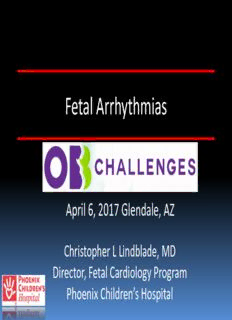
Fetal Arrhythmias PDF
Preview Fetal Arrhythmias
Fetal Arrhythmias April 6, 2017 Glendale, AZ Christopher L Lindblade, MD Director, Fetal Cardiology Program Phoenix Children’s Hospital No Financial Disclosures • I have no financial relationship with any manufacturer of any commercial product and/or provider of commercial services discussed in the conference. • I do not intend to discuss an unapproved/investigative use of a commercial product or device in my presentation Arrhythmia Evaluation • Rate – Fast or slow? • Rhythm – Regular or irregular? – Atrial rhythm or ventricular rhythm? Normal Conduction Fetal Arrhythmia Background • Complicates ~2% of all pregnancies • Account for 10-20% of referrals to pediatric cardiologist • Abnormal impulse generation or propagation • Various techniques – Fetal ECG – Magnetocardiography (fMCG) 2:1 AV Block Fetal Arrhythmia Background • Complicates ~2% of all pregnancies • Account for 10-20% of referrals to pediatric cardiologist • Abnormal impulse generation or propagation • Techniques – Fetal ECG – Magnetocardiography (fMCG) – Echocardiography Assess with M-mode or spectral Doppler Color and tissue Doppler may be helpful M-Mode Assessment • Place cursor across ventricular and atrial wall 1:1 AV Conduction Right Ventricle Left Atrium Color M-Mode Assessment Atrial Ventricular Spectral Doppler Assessment • E = early passive ventricular inflow from atrium • A = active atrial A systolic contraction stimulated by SA E node, mechanical event correlating with atrial electrical stimulation V Spectral Doppler Assessment MV-LVOT A E V
Description: